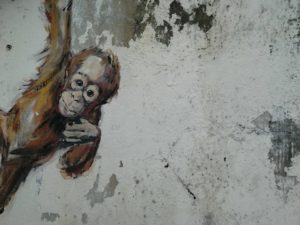Borneo

“The land is sacred. It belongs to the countless numbers who are dead,
the few who are living and the multitudes of those yet to be born”
Penan, Sarawak, Malaysia
At the moment, while few of us are travelling, we can all think back to places we have been to, and look forward to future trips.
A few years ago, while living in Indonesia, we had the opportunity to travel to Borneo, East Malaysia (Malaysia Timur) For us it was one of the best trips in South East Asia, during our three years there.
We flew to Kuching, a small town in the Sarawak area.
East Malaysia was a perfect destination for us; less populated and less developed than many parts of West Malaysia, where you will find Kuala Lumpur and Penang. There were not many tourists. We booked a small hotel in the centre of Kuching town.
Kuching is the Malay word for cat. Everywhere you went there were references to our little feline friends. There were cat paintings at the airport, cat sculptures dotted about the town and cat statues by the river. There was even a cat museum, apparently the world’s first feline museum. The museum was crammed with a vast range of artefacts and exhibits.
Meeeow.
A big appeal for us was that this destination offered such a range of cuisine. Our small hotel offered a selection of local dishes for breakfast including Laksa Sarawak, a spicy noodle soup and Kolo Eee, a noodle soup made from egg noodles. In the town we were able to find Chinese, Indian, Spanish and Italian food.
And there was so much to do. On one of our first days we went on a river safari, in search of Proboscis monkeys. These large primates are some of the largest monkeys in Asia. The males are recognisable by their oversized, long, fleshy noses and large, swollen bellies. As monkeys go, they were somewhat short changed in the looks department. Sadly, like so many animals in our world, the proboscis monkey is under threat in its natural environment.
We boarded a small boat, with a handful of other travellers. We chatted and quaffed. Eventually we reached a mangrove area, and from a distance we spotted the first monkey, leaping athletically form tree to tree. The driver switched off the engine and the vessel glided silently towards the bank and thick bush, affording us a closer look. It was magical to get so close to these strange looking creatures in the wild.
We travelled on to a small, stilted village. Like so many places you find some of the poorest people with the most generous smiles. We bought biscuits and chips for the boat. We stayed out on the river for some time, which immediately took us back to many trips like this in Southern Africa. Time passed, perhaps a little too much time and the light was fading fast. The driver said nothing. We wondered what we were waiting for, but then it became apparent. Suddenly the night sky around us was lit up by hundreds of fireflies.
More time by the Sarawak river gave us the chance to explore the esplanade. During the day we walked along the waterfront, taking in views of the north bank of the river. We jumped on and off the local water taxis, ‘Penambang‘ which was a lot of fun. That took us by The Astana (governor’s mansion) and over to Fort Margherita, where we found out more about Sarawak’s heritage and the rule of the Brooke family, during colonial times.
At night the area came alive with live music and street food; vendors selling multi-coloured layered cake, kek lapis and other merchandise. We would retreat from the crowds and wander in quieter streets, by Ernest Zacharevic’s impressive murals, at the west end of India Street. We had seen his work in Penang too.
We learned a bit more history at The Chinese History Museum, where there were displays of musical instruments, photographs and costumes. We also visited the Sarawak Museum, where we found out the original meaning of the term ‘headhunter’, indigenous tribes who scapled their victims.
An early start took us to the Semenggoh Wildlife Rehabiliation Centre, in search of orangutans. There are full day treks in the jungle, with no guarantee of seeing these magnificent animals or there is always a zoo somewhere. I won’t go to zoos. Semenggoh was a good option, as you can walk with a ranger in the hope of finding wild orangutans in the trees, or hangout near the spots sed for two daily feeding times, where you can watch these usually shy primates. We liked that Semenggoh’s goal is to reintroduce the orangutans back into the wild. None of the orangutans are caged.
Sarawak was a surpise. It was a place that we had never heard of before moving to South East Asia but it turned out to be a really memorable trip. It’s a lovely, laid back place, with so much to offer visitors.
Where will you be going next, once you can travel?
© Maggie M/ Mother City Time